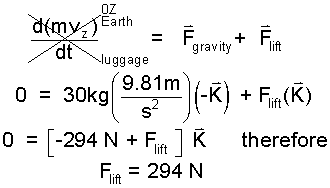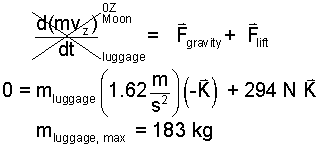| THERMO Spoken Here! ~ J. Pohl © | TOC NEXT ~ 35 |
Lunar "Carry-Off" Luggage

On Earth an astronaut can apply a certain "lifting force." The astronaut can also apply that magnitude of lifting force on the moon. The force to support 30 kilograms on Earth is determined from Newton's 2'nd Law.
To simply hold something while motionless is a case of uniform motion with the velocity being constant (and zero). The event of this example is a change of the source of gravitational force from being the Earth then later, the moon. (You should solve this problem with EE units also).
Calculation below shows, the force to support 30 kilograms on the Earth surface is 294 Newtons.
 | (1)
This event determines the "force" the astronaut can comfortably apply. |
On the moon, the astronaut can again apply this force to unload the capsule. Hence the mass that might be unloaded is 183 kilograms.

| (2)
The momentum equation, applied relative to the moon, determines the mass that can be unloaded. |
Notice the two events have separate inertial reference points. This different is not a problem since there is no motion (relative to the source of gravity) in either case.
Both Metric and English Engineering Units are used in the United States. English Engineering Units have a peculiarity as is demonstrated in the next example.
Lunar "Carry-Off" Luggage

Suppose on Earth an astronaut, using his maximum "lifting force," lifts 30 kilograms. Since unloading on the moon will be easier, let's use a forklift to load on Earth. What should be the mass such that the astronaut can apply the same magnitude of force to unload on the moon?
Premise presently unwritted!